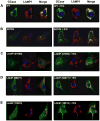The pharmacological chaperone isofagomine increases the activity of the Gaucher disease L444P mutant form of beta-glucosidase
- PMID: 20148966
- PMCID: PMC2874831
- DOI: 10.1111/j.1742-4658.2010.07588.x
The pharmacological chaperone isofagomine increases the activity of the Gaucher disease L444P mutant form of beta-glucosidase
Abstract
Gaucher disease is caused by mutations in the gene that encodes the lysosomal enzyme acid beta-glucosidase (GCase). We have shown previously that the small molecule pharmacological chaperone isofagomine (IFG) binds and stabilizes N370S GCase, resulting in increased lysosomal trafficking and cellular activity. In this study, we investigated the effect of IFG on L444P GCase. Incubation of Gaucher patient-derived lymphoblastoid cell lines (LCLs) or fibroblasts with IFG led to approximately 3.5- and 1.3-fold increases in L444P GCase activity, respectively, as measured in cell lysates. The effect in fibroblasts was increased approximately 2-fold using glycoprotein-enrichment, GCase-immunocapture, or by incubating cells overnight in IFG-free media prior to assay, methods designed to maximize GCase activity by reducing IFG carryover and inhibition in the enzymatic assay. IFG incubation also increased the lysosomal trafficking and in situ activity of L444P GCase in intact cells, as measured by reduction in endogenous glucosylceramide levels. Importantly, this reduction was seen only following three-day incubation in IFG-free media, underscoring the importance of IFG removal to restore lysosomal GCase activity. In mice expressing murine L444P GCase, oral administration of IFG resulted in significant increases (2- to 5-fold) in GCase activity in disease-relevant tissues, including brain. Additionally, eight-week IFG administration significantly lowered plasma chitin III and IgG levels, and 24-week administration significantly reduced spleen and liver weights. Taken together, these data suggest that IFG can increase the lysosomal activity of L444P GCase in cells and tissues. Moreover, IFG is orally available and distributes into multiple tissues, including brain, and may thus merit therapeutic evaluation for patients with neuronopathic and non-neuronopathic Gaucher disease.
Figures







Similar articles
-
Ex vivo and in vivo effects of isofagomine on acid β-glucosidase variants and substrate levels in Gaucher disease.J Biol Chem. 2012 Feb 3;287(6):4275-87. doi: 10.1074/jbc.M111.280016. Epub 2011 Dec 13. J Biol Chem. 2012. PMID: 22167193 Free PMC article.
-
Structure of acid beta-glucosidase with pharmacological chaperone provides insight into Gaucher disease.Nat Chem Biol. 2007 Feb;3(2):101-7. doi: 10.1038/nchembio850. Epub 2006 Dec 24. Nat Chem Biol. 2007. PMID: 17187079
-
Novel beta-glucocerebrosidase chaperone compounds identified from cell-based screening reduce pathologically accumulated glucosylsphingosine in iPS-derived neuronal cells.SLAS Discov. 2023 Oct;28(7):344-349. doi: 10.1016/j.slasd.2023.06.002. Epub 2023 Jun 25. SLAS Discov. 2023. PMID: 37369311
-
A comparative computational approach toward pharmacological chaperones (NN-DNJ and ambroxol) on N370S and L444P mutations causing Gaucher's disease.Adv Protein Chem Struct Biol. 2019;114:315-339. doi: 10.1016/bs.apcsb.2018.10.002. Epub 2018 Dec 1. Adv Protein Chem Struct Biol. 2019. PMID: 30635084 Review.
-
Gaucher disease among Chinese patients: review on genotype/phenotype correlation from 29 patients and identification of novel and rare alleles.Blood Cells Mol Dis. 2007 May-Jun;38(3):287-93. doi: 10.1016/j.bcmd.2006.11.003. Epub 2006 Dec 29. Blood Cells Mol Dis. 2007. PMID: 17196853 Review.
Cited by
-
GBA1-Associated Parkinson's Disease Is a Distinct Entity.Int J Mol Sci. 2024 Jun 28;25(13):7102. doi: 10.3390/ijms25137102. Int J Mol Sci. 2024. PMID: 39000225 Free PMC article. Review.
-
Histone deacetylase inhibitors prevent the degradation and restore the activity of glucocerebrosidase in Gaucher disease.Proc Natl Acad Sci U S A. 2011 Dec 27;108(52):21200-5. doi: 10.1073/pnas.1119181109. Epub 2011 Dec 12. Proc Natl Acad Sci U S A. 2011. PMID: 22160715 Free PMC article.
-
Inhibition of Clostridium difficile TcdA and TcdB toxins with transition state analogues.Nat Commun. 2021 Nov 1;12(1):6285. doi: 10.1038/s41467-021-26580-6. Nat Commun. 2021. PMID: 34725358 Free PMC article.
-
High-Dose Ambroxol Therapy in Type 1 Gaucher Disease Focusing on Patients with Poor Response to Enzyme Replacement Therapy or Substrate Reduction Therapy.Int J Mol Sci. 2023 Apr 4;24(7):6732. doi: 10.3390/ijms24076732. Int J Mol Sci. 2023. PMID: 37047707 Free PMC article.
-
Tool compounds robustly increase turnover of an artificial substrate by glucocerebrosidase in human brain lysates.PLoS One. 2015 Mar 12;10(3):e0119141. doi: 10.1371/journal.pone.0119141. eCollection 2015. PLoS One. 2015. PMID: 25763858 Free PMC article.
References
-
- Beutler E, Grabowski G. In: The Metabolic and Molecular Bases of Inherited Disease 2006. Scriver C, Beaudet A, Sly W, Valle D, editors. McGraw-Hill; New York: 2001.
-
- Butters TD. Gaucher disease. Curr Opin Chem Biol. 2007;11:412–418. - PubMed
-
- Beutler E, Gelbart T, West C. Identification of six new Gaucher disease mutations. Genomics. 1993;15:203–205. - PubMed
-
- Grabowski GA. Gaucher disease: Gene frequencies and genotype/phenotype correlations. Genet Test. 1997;1:5–12. - PubMed
MeSH terms
Substances
Grants and funding
LinkOut - more resources
Full Text Sources
Other Literature Sources
Medical
Molecular Biology Databases

